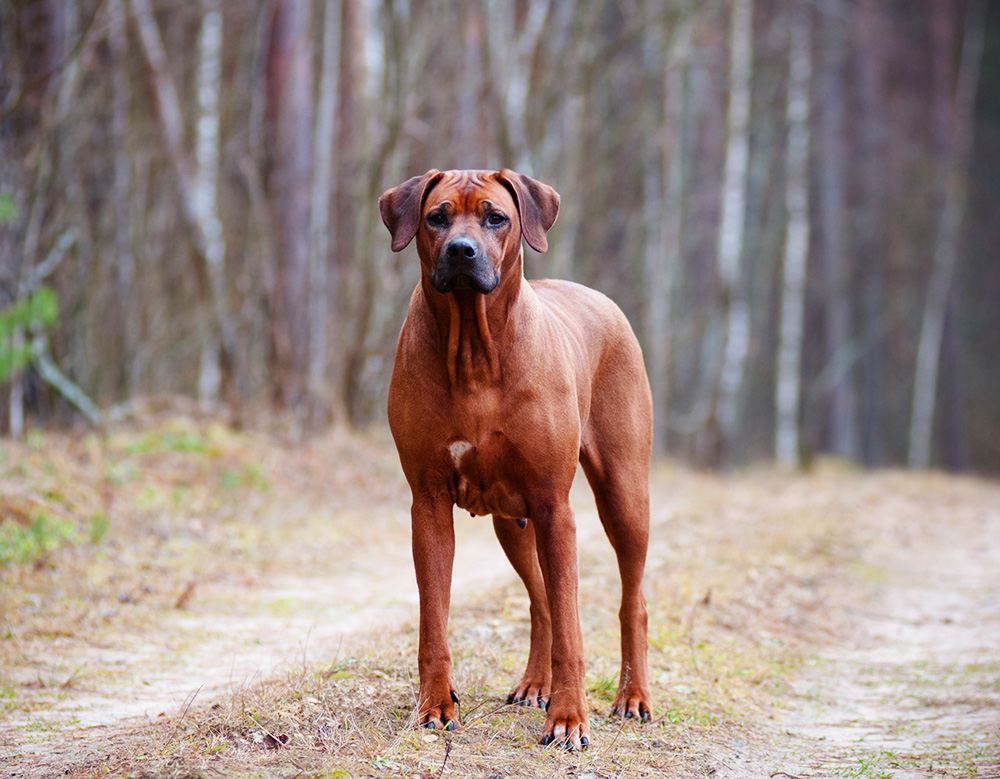Breed Profile – Rhodesian Ridgeback
07/12/2017
We’ve talked about this handsome breed before, but never done a proper breed guide, so it’s time to put that right. Despite an image as a fierce lion hunter, the Rhodesian Ridgeback is a good-natured breed. This interesting breed with its distinctive ‘ridgeback’ needs an experienced handler.
History of Breed: The Rhodesian Ridgeback originated in southern Africa, in Zimbabwe (formerly Rhodesia). It is probably a mixture of native African breeds and mastiff-type breeds taken there by European settlers. There have been disputes over its classification with past claims of gundog classification. However, The Kennel Club puts it in the hound class with other breeds that hunt by sight or scent. The Ridgeback’s traditional use was in lion hunting, hence its alternative name of African Lion Hound or African Lion Dog. The dog would use its tracking skills to hunt down the lion and was large enough and brave enough to hold the big cat at bay until the hunters arrived.
Life Expectancy: About 10-12 years.
Size: A large breed with a height range of 61-69cm and a weight range of 29-41kg.
Features: The Rhodesian Ridgeback takes its name from the characteristic ridge of fur along its back, which runs in the opposite direction to the rest of the coat. The Ridgeback’s coat is smooth, short and glossy, coming in light wheaten to red wheaten. Small amounts of white on the chest and toes is permissible. A strong, muscular dog, with powerful, straight legs. The head is of a fair length, skull flat and broad between the ears. A Ridgeback with a black nose had dark eyes and a dog with a brown nose has amber eyes. Tail is long and tapered with a slight curve, but never curling.
Energy Levels/Exercise Required: Bred for long days hunting in the African bush, the Rhodesian Ridgeback has high energy and stamina levels. They require more than two hours exercise per day to tire them out. Exercise that reflects their natural instinct for tracking will provide mental stimulation as well as physical activity. Any dog can develop behavioural problems if they do not receive enough exercise. However, this is particularly true of Ridgebacks, who can be difficult to deal with if they are bored or under-exercised.
A large dog with high energy levels needs a diet to reflect this. Gilpa Kennel contains 20% protein, 10% essential fats and oils plus vitamins and minerals for optimum nutrition. It also has a larger biscuit size for the larger mouths of big breeds such as the Rhodesian Ridgeback. This offers a good diet for Rhodesian Ridgebacks, but a formula like Dr John Titanium is normally a better choice for highly-active dogs, given the higher protein levels and enhanced dietary supplements.
Potential Health Problems: Dermoid sinus is a congenital neural-tube defect that affects Ridgebacks. Surgery rectifies the condition, but affected dogs should not breed. Likewise, degenerative myelopathy is another neurological disease affecting the breed. The disease, which causes progressive paraparesis, also affects German Shepherds and eventually leads to total loss of use of the rear limbs. A DNA test identifies dogs at risk of the disease and, again, these should not breed.
As a large, deep-chested breed, the Rhodesian Ridgeback is also at risk of developing GDV (gastric dilatation volvulus) or bloat. This potentially fatal condition occurs when the stomach fills with gas, fluid or food forcing it to expand and sometimes twist. This reduces blood flow around the body and puts pressure on other organs. Urgent treatment in the early stages can save a dog’s life. Owners can also take steps to reduce the risk by not feeding dogs too close to periods of exercise, giving two smaller meals per day and keeping the dog’s bowl at floor level.
Thyroid problems can also be common in this breed as well as hip dysplasia. Hip dysplasia is an inherited condition that has an early onset if puppies are over-exercised or dogs carry too much weight. Discouraging puppies from jumping from heights, using the stairs and exercising too much is vital prevention. Large breeds also have a period of rapid growth that needs to be carefully monitored to protect developing bones and joints. Furthermore, feeding to condition should prevent excessive weight gain. Gilpa Kennel, mentioned above, contains New Zealand green-lipped mussel extract, a natural source of chondroitin and glucosamine. This extract helps maintain bone and joint health.
Temperament: The Rhodesian Ridgeback is intelligent and affectionate, but can be stubborn. They need an experienced owner to take them on and respond best to reward-based, consistent, positive training. Early socialisation is vital. They are loyal and protective of their owners, whilst being aloof, but not aggressive, with strangers, making great guard dogs.
Child Friendly/Family Dog: An early-socialised, well-trained Ridgeback makes a good family dog. However, it goes without saying that adults should always supervise dogs and children. With large dogs and small children, the risk is greater from inadvertent crushing rather than aggression. The Rhodesian Ridgeback is happiest in a large house with a large garden or outside space, providing plenty of room to spread out or run off excess energy.
Likes: Affection from its favourite people, likely to be owners.
Dislikes: Lack of exercise, lack of attention, strangers.



